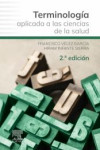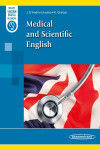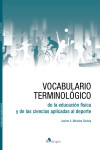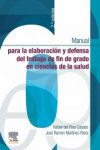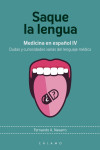CóMO REDACTAR TEXTOS CIENTíFICOS EN INGLéS
Nesbitt, David
Datos técnicos
- ISBN 9788416228959
- Año Edición 2020
- Páginas 560
- Encuadernación Rústica
- Idioma Español
Sinopsis
El propósito de este manual es de facilitar la publicación en inglés de artículos, libros, proyectos, posters y tesis científicas escritos en inglés por autores de habla española.
A pesar de que el español puede ser la segunda lengua más hablada en el mundo, incluso por encima del inglés, no hay otro manual en el mercado que trate las cuestiones específicasque surgen cuando un hispanoparlante redacta un trabajo técnico en inglés.
Este manual, con tres grandes apartados, realmente constituye tres libros en uno:
1. Una guía práctica para organizar y redactar un trabajo de forma rigurosa y eficiente;
2. Un manual de estilo para garantizar un escrito claro, atractivo y persuasivo; y
3. Una referencia lingüística para solucionar cuestiones de gramática, sintaxis y otros aspectos de la lengua inglesa.
El libro está escrito en inglés, puesto que es necesario para explicar temas de la escritura en esa lengua. El estilo es claro y sencillo, muchas veces con tono de humor para una lectura amena. Hay abundantes ejemplos de frases que contienen errores y las mismas frases corregidas. Se incluye material visual de apoyo para las explicaciones, así como modelos de escritos (ej. una carta al editor, un esquema de un artículo y un CV).
Es una herramienta nueva y valiosa para los científicos que pretenden publicar en inglés.
Índice
CHAPTER 1. A PRACTICAL GUIDE: THE ACT
OF WRITING FOR SCIENCE
1.1. A concept of writing for science
1.2. The structure of a paper
1.2.1. Abstract
1.2.2. Highlights
1.2.3. Key words (and key phrases)
1.2.4. Introduction
1.2.5. Materials and methods
1.2.6. Results
1.2.7. Discussion
1.2.8. Conclusion
1.3. Core issues for scientific writing
1.3.1. Scientific method 27
1.3.2. The aim
1.3.3. Verb tenses throughout the paper
1.4. Writing strategy: sequence of the
procedure
1.4.1. Setting the aim of the paper
1.4.2. Devising a title
1.4.3. Preparing an outline
1.4.4. First draft
1.4.5. Second draft
1.4.6. Tables, figures, maps, and photographs
1.4.7. Citations
1.4.8. Footnotes
1.4.9. Acknowledgments
1.4.10. References
1.4.11. Supplementary material
1.4.12. Biographical notes
1.4.13. Final proofreading.
1.4.14. Ensuring against plagiarism
1.4.15. Finishing
1.5. Submission of a manuscript
1.5.1. The journal
1.5.2. British or american english?
1.5.3. The cover letter
1.5.4. The peer review
1.6. Project applications and other proposals
1.6.1. Initial project information
1.6.2. Strategy for writing project applications
Oficina: C/ Cine 42,
28024 Madrid, España
Tel.: + 34 91 371 48 88
info@garceta.es
www.garceta.es
Ibergarceta Publicaciones S.L. CIF: B-85637882. Dirección fiscal: Paseo de las Acacias 20, 28005 Madrid
1.6.3. Congresses, workshops, seminars,
posters, and dissertations
1.7. Submitting a peer review
1.8. Curriculum vitae
1.9. Summary of chapter 1
CHAPTER 2. THE THEORY OF WRITING
2.1. The spirit of writing
2.1.1. Style
2.1.2. Clarity
2.1.3. Conciseness
2.1.4. Directness
2.1.5. Coherence and unity
2.1.6. Point of view
2.1.7. Tone
2.1.8. Criticism
2.1.9. Rigor
2.2. The issues of writing
2.2.1. Indirectness
2.2.2. Rhetorical questions and commands
2.2.3. Stilted prose and archaic language
2.2.4. Jargon and pseudo‐technical
language
2.2.5. Euphemism
2.2.6. Fashionable words and catch
phrases
2.2.7. Relaxed usage, colloquial usage,
slang
2.2.8. Opinions
2.2.9. Emphatic language
2.2.10. Absolutes
2.2.11. Repetitiveness
2.2.12. Redundancy and tautology
2.2.13. Word choice
2.3. Summary of chapter 2
CHAPTER 3.THE MECHANICS OF WRITING
3.1. Spelling
3.1.1. British vs. American spelling and
usage
3.1.2. Abbreviations
3.1.3. Capitalization
3.1.4. Spanish names in english
3.2 grammar
3.2.1. Articles
3.2.2. Nouns
3.2.3. Pronouns
3.2.4. Verbs
3.2.5. Adjectives
3.2.6. Adverbs
3.2.7. Conjunctions
3.2.8. Prepositions
3.2.9. The saxon genitive
3.3. Sentence structure and building
3.3.1. Phrases
3.3.2. Clauses
3.3.3. Sentences
3.3.4. Paragraphs
3.3.5. Word order
3.3.6. Parallel structure
3.4. Punctuation and symbols
3.4.1. Comma
3.4.2. Semicolon
3.4.3. Colon
3.4.4. Hyphen
3.4.5. Dash
3.4.6. Slash
3.4.7. Apostrophe
3.4.8. Period, dot, and ellipsis
3.4.9. Quotation marks
3.4.10. Parentheses and brackets
3.4.11. Numbers and other symbols
3.4.12. Italics, underlining, and bold
typeface
3.4.13. Overuse of punctuation and
other visual aids to writing
3.5. Summary of chapter 3.
Otros libros que te pueden interesar
- ¿Quiénes somos?
- Gastos de envío
- Política de privacidad
- Políticas de devolución y anulación
- Condiciones Generales de contratación
- Contacto
2025 © Vuestros Libros Siglo XXI | Desarrollo Web Factor Ideas






